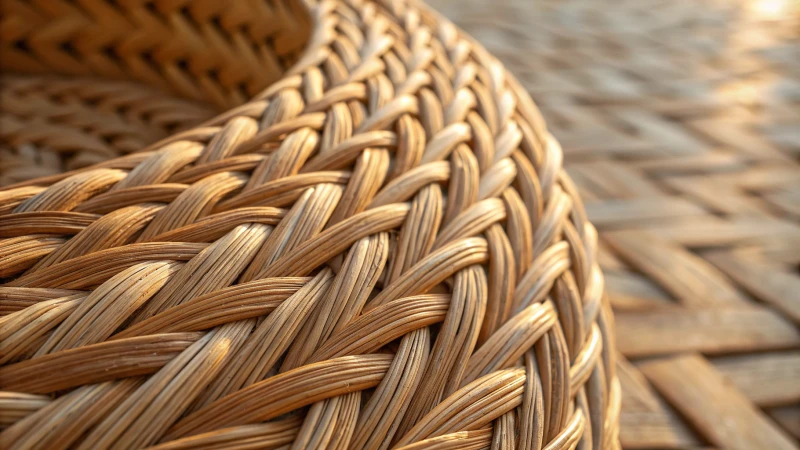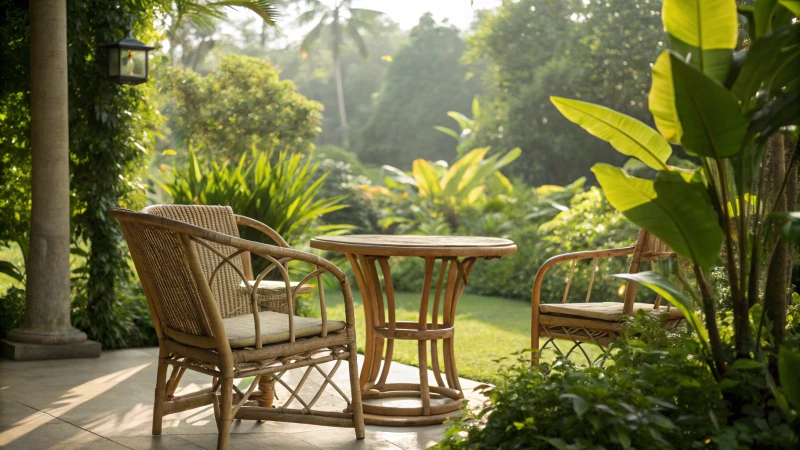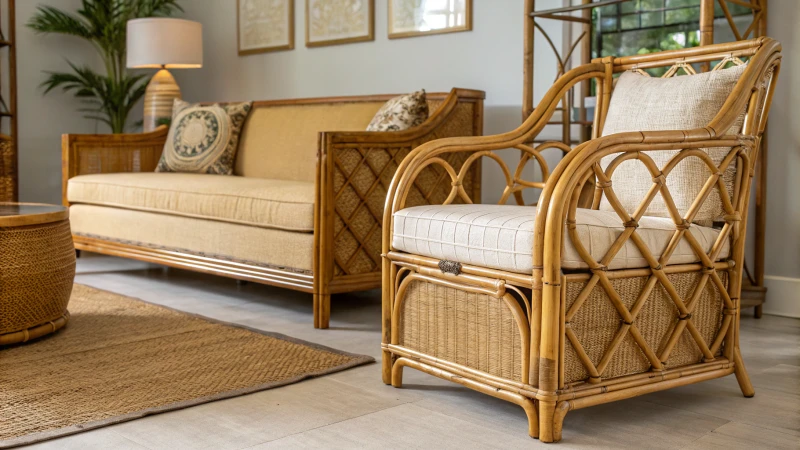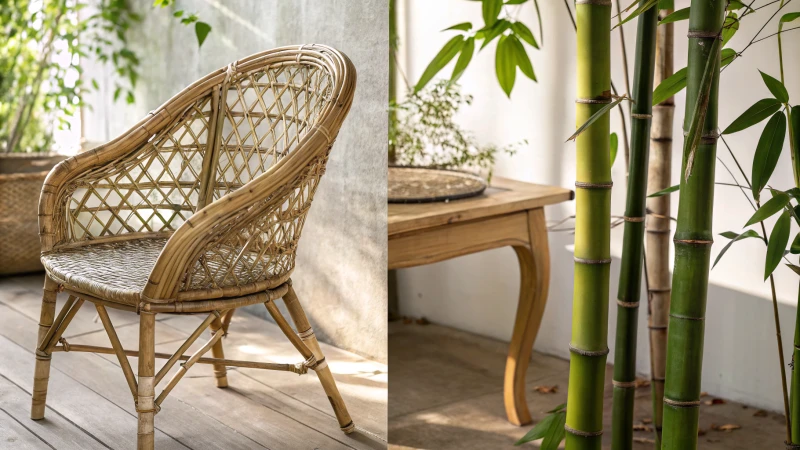
Do you feel uncertain about picking between rattan and bamboo cane for your home decor project? I understand. I have experienced that too!
Rattan and bamboo cane differ greatly in durability, flexibility, looks and price. Rattan offers strength and is very versatile. This makes it perfect for furniture. Bamboo, on the other hand, is lighter and often cheaper. Knowing these differences really helps in choosing what fits your decor needs best.
I have spent years creating beautiful spaces. I know that choosing the right materials really matters. People often confuse rattan and bamboo cane, but each has its unique qualities. Rattan is very strong and flexible. It is my choice for furniture that lasts long. Bamboo is lightweight and cheap. It is perfect for small decorative items. These items add charm without costing too much. Let’s explore these differences more. These insights will probably help you choose your decor with confidence.
Rattan is stronger than bamboo cane for furniture making.True
Rattan's strength and versatility make it more suitable for durable furniture compared to bamboo, which is lighter and less robust.
Bamboo cane is generally more expensive than rattan.False
Bamboo cane is often more affordable than rattan, making it a cost-effective choice for decor.
What Are the Unique Characteristics of Rattan?
Rattan is more than just a material. It tells a story of strength, sustainability and beauty. Rattan really has unique traits. Many people choose it for eco-friendly design.
Rattan is famous for its great strength and flexibility. It is eco-friendly and has charming looks. Rattan furniture needs very little upkeep. These traits make it a very good choice for sustainable furniture and décor.

Strength and Durability
Rattan holds a special allure beyond its appearance. I remember seeing a lovely rattan chair at a friend’s house. It was love at first sight! The smooth texture, warm natural fibers, and elegant design captivated me. Later, I discovered that rattan is known for its strength, flexibility, and eco-friendliness. It also looks beautiful and is easy to care for. This probably makes it a perfect choice for sustainable furniture and decor.
Rattan’s strength and flexibility amaze me. When exploring furniture options, I found rattan pieces handle heavy weight well. It stays strong and reliable like an old friend.
Key Properties:
| Property | Description |
|---|---|
| Tensile Strength | High resistance to tension |
| Flexibility | Can bend without breaking |
These characteristics allow for innovative designs that maintain aesthetic appeal while ensuring durability. Curious about including rattan in your home? Explore more at designing with rattan1.
Eco-Friendliness
I felt happy learning that rattan is gathered without harming tropical forests. Choosing this material supports our planet. This isn’t just a design choice; it is also a step towards a greener earth.
Benefits of Using Rattan:
- Biodegradable: Breaks down naturally, lessening landfill waste.
- Low Carbon Footprint: Uses minimal energy.
- Recyclable: Transformable into new items.
Every rattan choice feels like a small but meaningful effort for sustainability. Want to learn more about eco-friendly materials? Find out more at eco-friendly materials.
Aesthetic Appeal
Rattan’s natural textures and warm colors feel inviting. I daydream about how it fits perfectly in styles from bohemian to modern. It works well in any setting.
Versatile Applications:
- Furniture: Comfortable chairs, tables, and sofas.
- Decorative Items: Baskets, wall art, and light fixtures.
Possibilities are endless! Looking for decoration ideas with rattan? Check out using rattan in decor.
Maintenance and Care
Taking care of rattan is simpler than expected. Regular cleaning keeps it looking fresh for years.
Maintenance Tips:
| Task | Frequency | Method |
|---|---|---|
| Dusting | Weekly | Soft cloth or duster |
| Deep Cleaning | Monthly | Mild soap and water |
| Conditioning | Every 6 months | Natural oils |
Following basic care steps, I maintain my rattan’s original shine. Curious about more detailed tips? Visit the rattan maintenance guide.
In my experience with rattan, I found not just a material but a responsible way of living. Each item tells its story. I proudly share it with friends and family.
Rattan furniture can support significant weight without breaking.True
Rattan's high tensile strength allows it to withstand heavy loads, making it ideal for durable furniture.
Rattan is not a sustainable material for furniture production.False
Contrary to this claim, rattan is eco-friendly and sustainably harvested from forests.
How Does Bamboo Cane Compare in Terms of Durability?
Have you ever thought about using bamboo cane for your next project? I have definitely thought about it! Bamboo stands out because it is very strong. This strength might be the reason you choose it. Let’s explore why bamboo is a great choice among materials.
Bamboo cane lasts 5-10 years. It is durable for many uses. Its strength and moisture resistance are moderate. Rattan lasts longer because it is more resilient. Proper care allows bamboo to last longer.

Understanding Bamboo Cane Strength
When I first found bamboo cane, its beauty and eco-friendly nature amazed me. I thought about its strength, especially for furniture or building. I remember choosing materials for a project and being stuck between bamboo and rattan. Both were charming, but long-lasting quality is very important for things that need to last.
Bamboo cane has an amazing strength compared to its weight. This often surprises many, including me at first! It holds heavy loads and resists damage, making it a great choice for many uses. Moso bamboo is now my favorite for furniture. With good care, it can last years. This is very comforting when buying things.
Comparison Table of Strength
| Material | Lifespan (Years) | Strength (MPa) | Resistance to Moisture | Common Uses |
|---|---|---|---|---|
| Bamboo Cane | 5 – 10 | 100 – 150 | Moderate | Furniture, Flooring |
| Rattan | 10 – 20 | 50 – 100 | High | Furniture, Baskets |
The table shows bamboo cane’s lifespan is average compared to rattan’s lifespan which is long. Rattan handles wear well because of its natural strength and extra treatments for durability.
Factors Affecting Strength
-
Environmental Conditions: Bamboo cane doesn’t like moisture. Too much water can cause mold and decay. Rattan copes better in humid places. Think about this if you live in a tropical area.
-
Processing Techniques: How bamboo is treated matters a lot for its strength. I saw a workshop using carbonization methods. This helps bamboo resist insects and moisture. It was really interesting to see these methods protect its life.
-
Maintenance: Regular care is very important. Cleaning and sealing bamboo matters. A simple coat can greatly protect its strength.
If you love sustainable materials2 like me, knowing these facts is crucial when picking a material for your project.
Performance in Real Use
In real use – furniture making or building – strength is key. Bamboo cane is good when you need light materials but it isn’t always the best choice.
For example, in an outdoor project, I used treated bamboo to face weather conditions. It lasted well compared to untreated bamboo which would need replacing more often. This experience taught me to compare bamboo with materials like rattan, especially for buyers like us who want products that really last.
Bamboo cane has a lifespan of 5 to 10 years.True
This lifespan is influenced by processing and environmental conditions, making bamboo suitable for various applications with proper care.
Rattan is more durable than bamboo cane.True
Rattan typically lasts 10 to 20 years, offering higher natural resilience compared to bamboo's moderate durability.
What Are the Aesthetic Differences Between Rattan and Bamboo Cane?
Are you excited to explore the interesting world of rattan and bamboo? These beautiful materials have the power to change your home decor. They reflect your personal style. Rattan and bamboo bring a unique touch. Your space becomes very special with them.
Rattan has a warm golden color. It feels smooth. Bamboo looks rugged and has visible joints. Rattan and bamboo give different styles. Each has unique textures. Real differences in feel exist. Select based on what you want to touch and see.

Visual Characteristics
Rattan and bamboo cane have distinctive visual traits that influence their use in home décor.
- Color: Rattan usually shows a rich golden brown color, giving it a warm and cozy feeling. It’s like a gentle hug for your space. Bamboo, on the other hand, has different colors ranging from soft yellows to deep greens, depending on its type and treatment. It brings an earthy vibrancy that makes any room feel full of life.
- Texture: Rattan feels smooth and has a subtle shine, making it perfect for modern designs. Bamboo has a rugged charm with visible nodes and joints that give it a natural quality. Nature lovers really connect with it.
These features let homeowners choose materials that reflect their style—some like natural warmth while others prefer earthy ruggedness.
Style Compatibility
When considering how rattan or bamboo fits into your home style, I see it like this:
| Style Type | Rattan | Bamboo |
|---|---|---|
| Modern | Shines in sleek furniture with curves | Looks great in geometric designs |
| Bohemian | Versatile woven pieces with intricate details | Fits well with natural, raw finishes |
| Traditional | Classic chairs and tables | Rustic accents |
| Contemporary | Minimalist designs | Bold statement pieces |
Rattan often shines in modern and bohemian spaces due to its versatility, while bamboo looks great in traditional and contemporary rooms. Understanding this helps us create spaces that match our vision. For more insights on design compatibility3, explore different themes.
Tactile Qualities
The feel of these materials affects their use in different places:
- Rattan: Its smooth surface is inviting for casual seating or decorations, making spaces cozy and comfortable.
- Bamboo: Its texture might be less polished but is very durable; outdoors, it stands strong against weather conditions.
I often choose rattan for indoor lounging areas as it creates a relaxed atmosphere. Bamboo is better for outdoor designs as it fits perfectly with the intended use.
Durability and Maintenance
Aesthetic appeal captures hearts while durability keeps homes looking great over time:
- Rattan: With proper care, it lasts for years but requires regular maintenance to prevent wear and tear.
- Bamboo: Naturally stronger than rattan, it handles tougher conditions well—ideal for high-traffic zones or outdoor spaces.
Knowing the care these materials need is very important as it helps buyers make thoughtful decisions. Understanding maintenance aligns with our lifestyle and design dreams. To learn more about material longevity4, check out the latest studies on furniture care.
Rattan has a golden brown hue, while bamboo varies in color.True
Rattan typically presents a warm golden brown color, contrasting with bamboo's range from light yellow to dark green, depending on species and treatment.
Bamboo is more durable than rattan for outdoor use.True
Bamboo's natural strength makes it ideal for outdoor furniture, while rattan requires careful maintenance and is less suited for harsh conditions.
Which Material Is More Sustainable: Rattan or Bamboo?
When I think about sustainability, I often wonder about the benefits of different materials. Rattan and bamboo really interest me. I am curious about them. I try to choose more eco-friendly options in my life.
Bamboo grows very quickly and captures a lot of carbon dioxide. Rattan is strong and its harvesting is sustainable. Both materials are eco-friendly. Knowing their unique features helps you choose wisely.

Understanding Rattan and Bamboo
Both rattan and bamboo are popular materials in the sustainable product market, yet they have distinct characteristics that impact their sustainability.
Rattan: A Closer Look
Rattan is a vine-like palm that thrives in tropical climates. It grows in tangled clusters, making it easier to harvest without causing significant damage to the environment. Rattan is known for its durability and flexibility, which makes it an ideal choice for furniture and home decor.
Key Facts About Rattan:
- Growth Rate: Rattan takes about 5-7 years to reach maturity.
- Harvesting: Can be sustainably harvested without harming the plant or ecosystem.
- End of Life: Biodegradable and can be recycled into other products.
For more insights into rattan’s unique properties, explore our rattan guide5.
Bamboo: Nature’s Fast Grower
In contrast, bamboo is a grass species that is renowned for its rapid growth, often reaching maturity within 3-5 years. Bamboo can grow up to 91 cm (35 inches) in just one day under optimal conditions, making it one of the fastest-growing plants on Earth.
Key Facts About Bamboo:
- Growth Rate: Matures in 3-5 years, faster than rattan.
- Carbon Sequestration: Absorbs more CO2 than traditional trees, contributing positively to the environment.
- End of Life: Also biodegradable but can take longer to break down compared to rattan.
For deeper analysis on bamboo’s sustainability benefits, check out our bamboo overview6.
Environmental Impact Comparison
To better understand the sustainability of these two materials, let’s compare them based on several factors:
| Factor | Rattan | Bamboo |
|---|---|---|
| Growth Rate | 5-7 years | 3-5 years |
| Harvesting Impact | Minimal damage to ecosystem | Minimal damage, quick regrowth |
| Carbon Footprint | Lower due to slow growth | Higher absorption rate |
| Biodegradability | Biodegradable | Biodegradable |
| Versatility | Flexible, suitable for various uses | Strong, great for construction |
Market Trends and Consumer Preferences
As consumers become increasingly eco-conscious, the demand for sustainable materials is rising. Brands like Rattalux cater to this demand by sourcing responsibly harvested rattan products that align with modern aesthetic preferences. Similarly, bamboo products are gaining popularity due to their rapid growth and strong environmental benefits.
For those interested in exploring sustainable sourcing practices, our article on eco-friendly materials7 provides valuable insights.
Bamboo matures faster than rattan.True
Bamboo reaches maturity in 3-5 years, while rattan takes 5-7 years to mature.
Rattan is less biodegradable than bamboo.False
Both rattan and bamboo are biodegradable, but rattan breaks down faster than bamboo.
Conclusion
Discover the essential differences between rattan and bamboo cane in terms of durability, aesthetics, and sustainability to make informed choices for your home decor.
-
Explore this link to understand how rattan’s properties can enhance your design choices and inform your purchases. ↩
-
Explore comprehensive resources on bamboo durability that will enhance your understanding and decision-making process for your projects. ↩
-
This resource provides tips on maintaining the beauty of rattan and bamboo products over time. ↩
-
Discover expert advice on selecting the right materials for your interior design projects. ↩
-
Discover the environmental benefits of bamboo over rattan to make informed choices in sustainable products. ↩
-
Learn about the lifecycle impacts of rattan products for a comprehensive understanding of their sustainability. ↩
-
Explore sourcing practices for both materials and how they align with eco-friendly consumer trends. ↩

